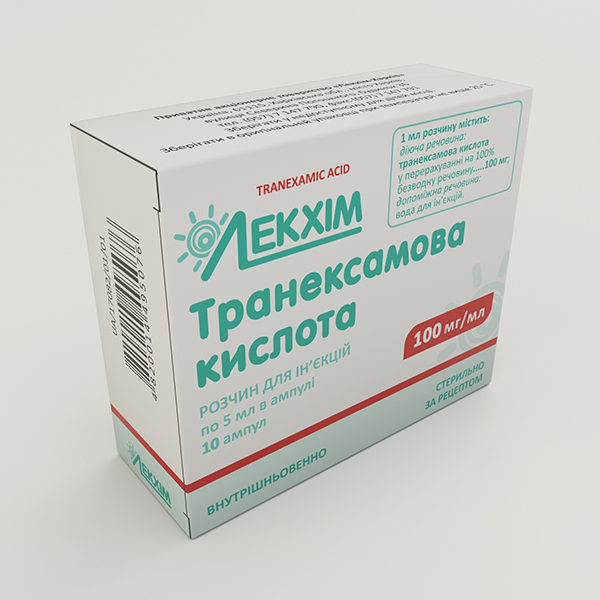Tranexamic acid

( TRANEXAMIC ACID )
Storage:
active substance : tranexamic acid;
1 ml of the solution contains 100 mg of tranexamic acid as a 100% anhydrous substance;
excipient : water for injections.
Medicinal form. Solution for injections.
Main physicochemical properties: transparent colorless or light brown liquid.
Pharmacotherapeutic group. Antihemorrhagic agents, antifibrinolytic amino acids. Inhibitors of fibrinolysis. ATX code B02A A02.
Pharmacological properties .
Pharmacodynamics .
Tranexamic acid is a competitive inhibitor of plasminogen activation, and in much higher concentrations is a non-competitive inhibitor of plasmin, that is, it acts similarly to aminocaproic acid. Tranexamic acid is approximately 10 times more active in vitro than aminocaproic acid.
Tranexamic acid binds more strongly than aminocaproic acid to the strong and weak receptor sites of the plasminogen molecule in a ratio corresponding to the difference in activity between the compounds. Tranexamic acid at a concentration of 1 mg/ml does not cause platelet aggregation in vitro .
Tranexamic acid, even at concentrations as low as 1 mg/ml, can prolong thrombin time. However, tranexamic acid at blood concentrations up to 10 mg/ml did not affect platelet count, clotting time, or other coagulation factors in whole blood or citrated blood of healthy subjects.
The binding of tranexamic acid to plasma proteins is approximately 3% at the therapeutic level of the substance in the plasma and is probably fully responsible for its binding to plasminogen. Tranexamic acid does not bind to serum albumin.
Pharmacokinetics .
After intravenous administration of a dose of 1 g, the plasma concentration-time curve is characterized by a three-exponential decrease with a half-life of approximately 2 hours for the final phase of elimination. The initial volume of distribution is approximately 9 to 12 liters. Urinary excretion is the main route of excretion, which occurs due to glomerular filtration. The total renal clearance is equal to the total plasma clearance (110-116 ml/min), and more than 95% of the dose is excreted unchanged in the urine. Excretion of tranexamic acid is approximately 90% within 24 hours after intravenous administration of 10 mg/kg of body weight.
The antifibrinolytic concentration of tranexamic acid is maintained in various tissues for approximately 17 hours, and in serum for up to 7-8 hours.
Tranexamic acid crosses the placenta. The concentration in umbilical cord blood after intravenous administration of 10 mg/kg to pregnant women is approximately 30 mg/l, that is, it is as high as in maternal blood. Tranexamic acid diffuses rapidly into the synovial fluid and synovial membrane. In the synovial fluid, the same concentrations of the substance as in the serum are achieved. The biological elimination half-life of tranexamic acid from the synovial fluid is approximately 3 hours.
The concentration of tranexamic acid in a number of other tissues is lower than in the blood. The concentration of the substance in breast milk is approximately 1/100 of the maximum concentration in serum. The concentration of tranexamic acid in the cerebrospinal fluid is approximately 1/10 of the concentration in plasma. The drug penetrates into the aqueous humor of the eye, and its concentration in it is approximately 1/10 of the concentration in plasma.
Clinical characteristics.
Testimony .
The drug "Tranexamic acid" is indicated for use in patients with hemophilia for short-term use (within 2-8 days) in order to reduce or prevent bleeding, as well as to reduce the need for replacement therapy during and after tooth extraction.
Contraindication.
– Acquired color vision impairment (this precludes measurement of a single endpoint that should be monitored as an indicator of toxicity).
– Subarachnoid hemorrhage (tranexamic acid can cause cerebral edema and cerebral infarction).
– Active intravascular blood coagulation.
– Hypersensitivity to tranexamic acid or to the excipient.
Interaction with other medicinal products and other types of interactions.
Studies of interactions between tranexamic acid and other medicinal products have not been conducted.